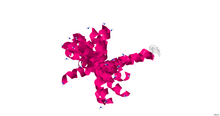Cecropin
| Cecropin family | |||||||||
|---|---|---|---|---|---|---|---|---|---|
 2IGR ? | |||||||||
| Identifiers | |||||||||
| Symbol | Cecropin | ||||||||
| Pfam | PF00272 | ||||||||
| InterPro | IPR000875 | ||||||||
| PROSITE | PDOC00241 | ||||||||
| SCOP | 1f0d | ||||||||
| SUPERFAMILY | 1f0d | ||||||||
| TCDB | 1.C.17 | ||||||||
| OPM superfamily | 160 | ||||||||
| OPM protein | 1d9j | ||||||||
| |||||||||
Cecropins are antimicrobial peptides.[1][2] They were first isolated from the hemolymph of Hyalophora cecropia, whence the term cecropin was derived. Cecropins lyse bacterial cell membranes; they also inhibit proline uptake and cause leaky membranes.
Cecropins[3][4][5] constitute a main part of the cell-free immunity of insects. Cecropins are small proteins of about 31 - 37 amino acid residues active against both Gram-positive and Gram-negative bacteria. Cecropins isolated from insects other than Hyalophora cecropia (Cecropia moth) have been given various names; bactericidin, lepidopterin, sarcotoxin, etc. All of these peptides are structurally related.
Members
Members include :
- Cecropin A
- Peptide Sequence (KWKLFKKIEKVGQNIRDGIIKAGPAVAVVGQATQIAK). Secondary structure includes two α helices.[6]:4.2 At low peptide to lipid ratios ion channels are formed, at high peptide to lipid ratios pores are formed.[7]
- Cecropin B
- Peptide Sequence (KWKVFKKIEKMGRNIRNGIVKAGPAIAVLGEAKAL). Secondary structure includes two α helices.[6]:4.2
- CECD
- from Aedes aegypti (Yellowfever mosquito).[8]
- Papiliocin
- (A lepidopteran) from Papilio xuthus[8] an Asian swallowtail butterfly.
- Cecropin P1
- Peptide Sequence (SWLSKTAKKLENSAKKRISEGIAIAIQGGPR). An antibacterial peptide from Ascaris suum, a parasitic nematode that resides in the pig intestine, also belongs to this family.
Derivatives
A derivative of Cecropin B is an anticancer polypeptide(L). Structure consists of mainly alpha helixes, determined by solution NMR. Protein molecular weight = 4203.4g/mol.[9]
Some of the cecropins (e.g. cecropin A, and cecropin B) have anticancer properties and are called anticancer peptides (ACPs).[6]:3 Hybrid ACPs based on Cecropin A have been studied for anticancer properties.[6]:7.1
References
- ↑ Cecropins at the US National Library of Medicine Medical Subject Headings (MeSH)
- ↑ Lauwers A, Twyffels L, Soin R, Wauquier C, Kruys V, Gueydan C (January 2009), "Post-transcriptional regulation of genes encoding anti-microbial peptides in Drosophila", J. Biol. Chem., 284 (13): 8973–83, doi:10.1074/jbc.M806778200, PMC 2659254
 , PMID 19176529.
, PMID 19176529. - ↑ Boman HG, Hultmark D (1987), "Cell-free immunity in insects", Annu. Rev. Microbiol., 41: 103–126, doi:10.1146/annurev.mi.41.100187.000535, PMID 3318666.
- ↑ Boman HG (1991), "Antibacterial peptides: key components needed in immunity", Cell, 65 (2): 205–207, doi:10.1016/0092-8674(91)90154-Q, PMID 2015623.
- ↑ Boman HG, Faye I, Lee JY, Gudmundsson GH, Lidholm DA (1991), "Cell-free immunity in Cecropia. A model system for antibacterial proteins", Eur. J. Biochem., 201 (1): 23–31, doi:10.1111/j.1432-1033.1991.tb16252.x, PMID 1915368.
- 1 2 3 4 Hoskin, D.W.; Ramamoorthy, A. (February 2008), "Studies on anticancer activities of antimicrobial peptides", Biochimica et Biophysica Acta (BBA) - Biomembranes, 1778 (2): 357–375, doi:10.1016/j.bbamem.2007.11.008, PMC 2238813
 , PMID 18078805
, PMID 18078805 - ↑ Loraine Susan Silvestro, "Function and structure of cecropin A" (January 1, 2000). Dissertations available from ProQuest. Paper AAI9965567. http://repository.upenn.edu/dissertations/AAI9965567
- 1 2 cecropin family OPM
- ↑ Protein Data Bank (1930), Solution structure of CB1a, a novel anticancer peptide derived from natural antimicrobial peptide cecropin B [<http://www.rcsb.org/pdb/explore/explore.do?structureId=2IGR> <Protein Data Bank>]
Further reading
- Hoskin 2008 (above) section 4.2